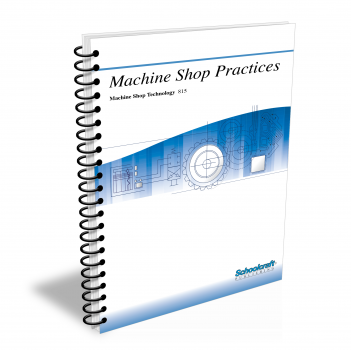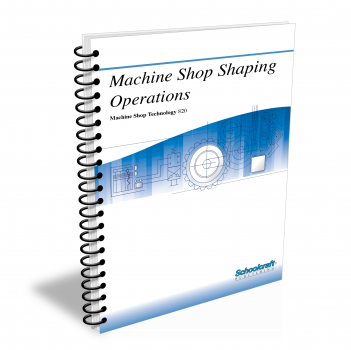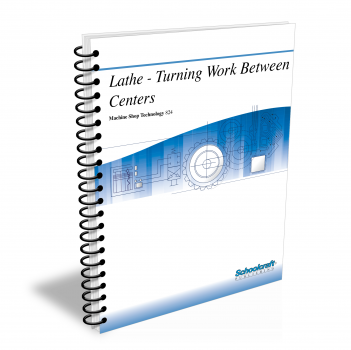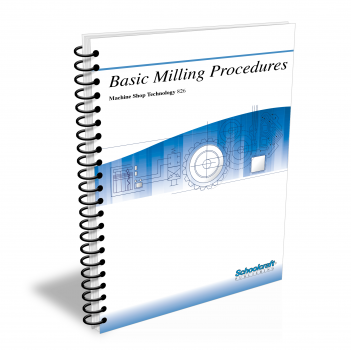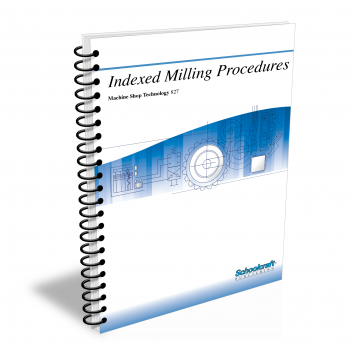Machine Shop Turning Operations

Course Number: 816
The Machine Shop Turning Operations textbook covers the major types of lathes and their attachments, safety, maintenance, job preparation, and basic lathe operations. It discusses all facets of drilling and boring, types of drills and drill presses, milling machines, and job bores. It explains reaming and reamer terms as well as threads and threading.
Does your curriculum require additional topics not included in this textbook? Build a customized version of the Machine Shop Turning Operations textbook below.
Recommended Contact Hours – 8
Preview a Chapter
Available Supporting Material
- Table of Contents
- Exam Copies
- Suggested Titles
Table of Contents
Chapter 1: Lathes and Attachments
Topics: Engine lathes; Lathe size, capacity, and parts; Holding work; Steady and follower rest; Preparing for lathe operation; Safety
Learning Objectives:
- Explain the function of each of the following lathe parts: lathe bed, ways, headstock, tailstock, carriage, compound rest, and spindle.
- Name the two dimensions usually used to describe lathe capacity.
- List and describe several methods of holding work in a lathe.
- Explain the function of a steady rest and follower rest.
Chapter 2: Basic Lathe Operations
Topics: Preparing and centering the stock; Aligning and using rests; Cutting speed and feed; Turning operations; Cutting fluids and coolants
Learning Objectives:
- Describe the factors to consider when selecting and preparing a piece of stock for a lathe job.
- Explain how to mount eccentric or irregularly shaped workpieces.
- Define the terms cutting speed and feed rate and list factors that affect each.
- Name two factors that affect the smoothness of a finishing operation.
- Explain the function of cutting fluid in lathe work.
Chapter 3: Drilling and Boring
Topics: Drills and drill presses; Drill numbering and sizing; Setting up work; Speed and feed; Drilling compounds; Boring; Safety
Learning Objectives:
- Identify the main parts of a twist drill.
- Explain the step-by-step procedure for drilling a hole.
- Demonstrate how to convert speed in surface feet per minute to inches per minute.
- Describe safety precautions to observe when working with a drill press.
- Describe the boring procedure and tell when it is used
Chapter 4: Reaming
Topics: Carbide-tipped reamers; Selection; Reaming speeds and feeds; Cutting fluids; Chatter; Troubleshooting; Counterboring; Spotfacing
Learning Objectives:
- Identify the main parts of a reamer
- Tell what reaming method is best to use when a very accurate hole is required
- Describe the benefits and uses of the following reamers: shell, hand, adjustable, expansion, taper, high speed steel, and carbide tipped
- Explain how to remove burrs from the cutting edges or teeth of a reamer
- Define counterboring, countersinking, and spotfacing
Chapter 5: Threads and Threading
Topics: Common thread series; Thread ID; Tapping; Tap sets; Drilling a hole to be tapped; Tapping pipe threads; Threading with dies; Measuring threads
Learning Objectives:
- Describe and state the uses of the following threads: National, square, Acme, and Buttress.
- Explain how the sizing of pipe threads differs from the sizing of other threads.
- Explain when to use each of the following taps: plug, taper, bottoming, spiral-pointed, spiral-fluted, and fluteless.
- Tell why cutting fields are used in tapping operations.
- Explain how to deal with long chips when tapping.
Request Exam Copies
Exam Copies
Ready to see a copy of our textbooks? After selecting which textbooks you’d like to review for your course, you can submit your request by either logging in or creating an account so we know where to ship your exam copies. A representative from Schoolcraft will contact you to confirm and finish processing your request.
Exam copies are always free and yours to keep.
Selected Exam Copies
none selected
* Maximum of five copies can be ordered
